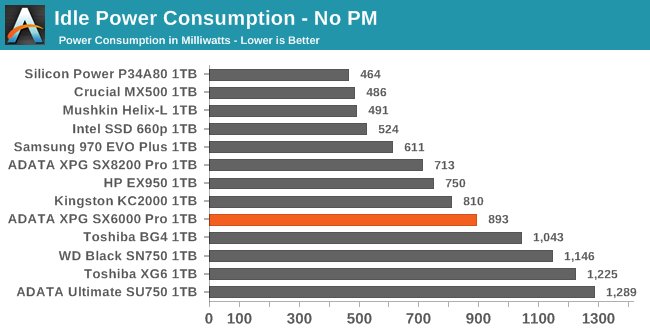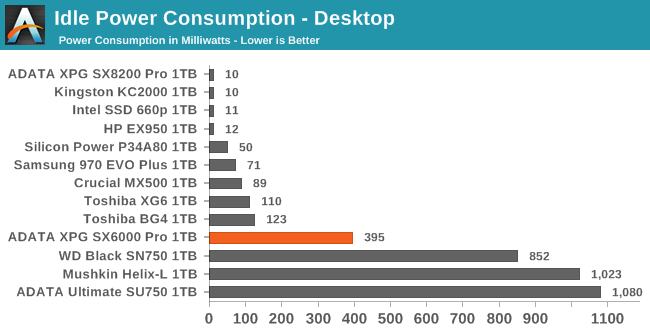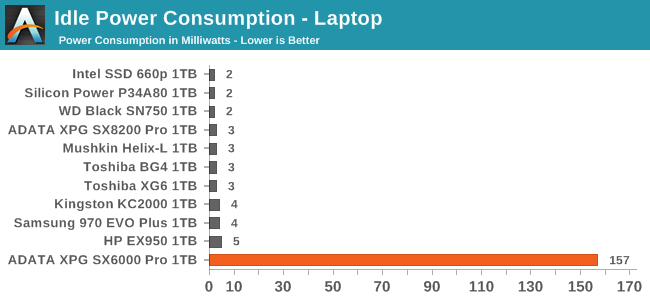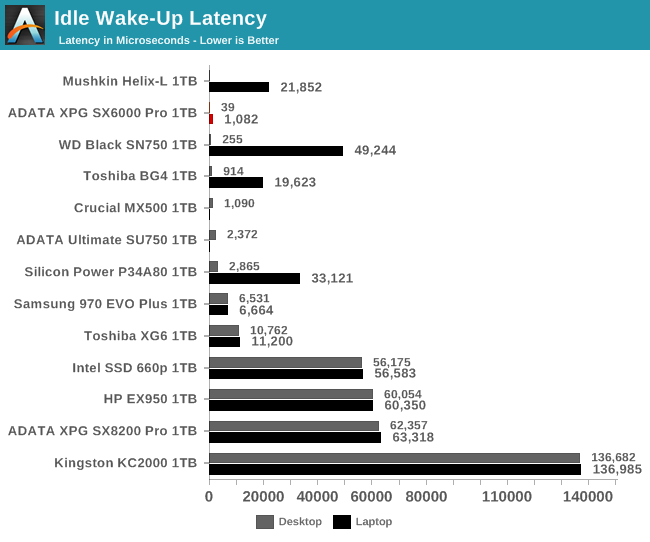The ADATA XPG SX6000 Pro 1TB SSD Review: Realtek's Entry-level NVMe Solution
by Billy Tallis on December 18, 2019 12:30 PM ESTPower Management Features
Real-world client storage workloads leave SSDs idle most of the time, so the active power measurements presented earlier in this review only account for a small part of what determines a drive's suitability for battery-powered use. Especially under light use, the power efficiency of a SSD is determined mostly be how well it can save power when idle.
For many NVMe SSDs, the closely related matter of thermal management can also be important. M.2 SSDs can concentrate a lot of power in a very small space. They may also be used in locations with high ambient temperatures and poor cooling, such as tucked under a GPU on a desktop motherboard, or in a poorly-ventilated notebook.
| ADATA XPG SX6000 Pro NVMe Power and Thermal Management Features |
|||
| Controller | Realtek RTS5763DL | ||
| Firmware | V9001c19 | ||
| NVMe Version |
Feature | Status | |
| 1.0 | Number of operational (active) power states | 3 | |
| 1.1 | Number of non-operational (idle) power states | 2 | |
| Autonomous Power State Transition (APST) | Supported | ||
| 1.2 | Warning Temperature | 118°C | |
| Critical Temperature | 150°C | ||
| 1.3 | Host Controlled Thermal Management | Not Supported | |
| Non-Operational Power State Permissive Mode | Not Supported | ||
The ADATA SX6000 Pro declares comically high warning and critical temperature thresholds which we don't believe for a minute, but we are inclined to believe that thermal throttling is a pretty remote possibility for this drive. It doesn't implement either of the relevant NVMe 1.3 power and thermal management features, but only one of those two is commonly found on competing drives.
The SX6000 Pro's firmware claims to have two idle power states that are both very low power, with reasonably fast transition times. This doesn't match up with ADATA's published spec sheet, which only claims that the drive can get down to about 140mW at idle.
| ADATA XPG SX6000 Pro NVMe Power States |
|||||
| Controller | Realtek RTS5763DL | ||||
| Firmware | V9001c19 | ||||
| Power State |
Maximum Power |
Active/Idle | Entry Latency |
Exit Latency |
|
| PS 0 | 8 W | Active | - | - | |
| PS 1 | 4 W | Active | - | - | |
| PS 2 | 3 W | Active | - | - | |
| PS 3 | 12.8 mW | Idle | 4 ms | 8 ms | |
| PS 4 | 8.0 mW | Idle | 8 ms | 30 ms | |
Note that the above tables reflect only the information provided by the drive to the OS. The power and latency numbers are often very conservative estimates, but they are what the OS uses to determine which idle states to use and how long to wait before dropping to a deeper idle state.
Idle Power Measurement
SATA SSDs are tested with SATA link power management disabled to measure their active idle power draw, and with it enabled for the deeper idle power consumption score and the idle wake-up latency test. Our testbed, like any ordinary desktop system, cannot trigger the deepest DevSleep idle state.
Idle power management for NVMe SSDs is far more complicated than for SATA SSDs. NVMe SSDs can support several different idle power states, and through the Autonomous Power State Transition (APST) feature the operating system can set a drive's policy for when to drop down to a lower power state. There is typically a tradeoff in that lower-power states take longer to enter and wake up from, so the choice about what power states to use may differ for desktop and notebooks, and depending on which NVMe driver is in use. Additionally, there are multiple degrees of PCIe link power savings possible through Active State Power Management (APSM).
We report three idle power measurements. Active idle is representative of a typical desktop, where none of the advanced PCIe link or NVMe power saving features are enabled and the drive is immediately ready to process new commands. Our Desktop Idle number represents what can usually be expected from a desktop system that is configured to enable SATA link power management, PCIe ASPM and NVMe APST, but where the lowest PCIe L1.2 link power states are not available. The Laptop Idle number represents the maximum power savings possible with all the NVMe and PCIe power management features in use—usually the default for a battery-powered system but rarely achievable on a desktop even after changing BIOS and OS settings. Since we don't have a way to enable SATA DevSleep on any of our testbeds, SATA drives are omitted from the Laptop Idle charts.
Note: Earlier this year we upgraded our power measurement equipment and switched to measuring idle power on our Coffee Lake desktop, our first SSD testbed to have fully-functional PCIe power management. The below measurements are all new, and are not a perfect match for the older measurements in our previous reviews and the Bench database.



ADATA's spec sheet proves to be more accurate than the drive's own firmware when it comes to idle power draw; the controller's deepest sleep states don't really work, and the lowest power levels we observed from the SX6000 Pro are more in line with pre-DEVSLP SATA drives. We really aren't surprised to see Realtek stumble here since literally everyone else in the industry has had trouble with this at one time or another. This is nowhere near the worst case of broken SSD power management we've seen. We wouldn't really recommend the SX6000 Pro for mobile use, but its power management should be fine to keep idle temperatures low during desktop use.

Since the SX6000 Pro doesn't actually get into any particularly deep sleep states, it's nice to see that it has extremely fast wake-up times; there's basically no downside to using the power management capabilities this drive does have working.










36 Comments
View All Comments
Samus - Wednesday, December 18, 2019 - link
I don’t think you are being critical enough of this drive. It is appallingly bad. It’s basically outclassed by SATA drives from years ago in almost every metric except sequential performance (where NVMe will naturally excel)But real world performance is terrible, power usage is high (and it has broken devsleep) and it isn’t very cheap. When you consider reliability is a total u known I’m struggling to imagine a single person who would consider this.
Billy Tallis - Wednesday, December 18, 2019 - link
Let me make it a bit clearer for you: https://www.anandtech.com/bench/product/2533?vs=22...The MX500 beats the SX6000 Pro on just ONE of those performance metrics. The picture's not that different if you compare against a Samsung SATA drive. Overall performance is clearly much better than a SATA SSD. It's not appallingly bad. It just isn't a high-end NVMe drive.
DPUser - Wednesday, December 18, 2019 - link
Appallingly Clearer. : )Alistair - Wednesday, December 18, 2019 - link
haha nice :)JoeyJoJo123 - Wednesday, December 18, 2019 - link
Based Billy Tallis *dabbing* on the n00bs in the comments section. FACTS don't care about your feelings, Samus. It's times like this I'm glad you can't edit your comments, since moments like these are eternalized forever.MFinn3333 - Wednesday, December 18, 2019 - link
To be fair, the Samsung 850 Pro does beat it in the sustained random read/writes, power efficiency of said read/writes and uses a lot less power while active idle.https://www.anandtech.com/bench/product/2310?vs=25...
(Blue is Samsung and Orange is ADATA because Samsung is blue in my mind).
To be fairer, the Samsung is at least five years old, costs three times as much if you can get it, and has an idle response that is 15X worse than the ADATA. The ADATA is clearly the better drive for 99% of the population.
The_Assimilator - Wednesday, December 18, 2019 - link
It's absolutely appallingly bad. You can't simply excuse broken power management with "the other vendors messed it up too", the point is that none of those other vendors have messed it up NOW. Realtek failed to learn from and avoid their competitors' mistake, and by doing so have introduced their controller with a handicap versus the same competitors. It's also both unproven, slower, and more expensive than older controllers that do have a known track record, so that's four strikes against the RTS5763DL.In contrast, drives using the two-year-old SM2263XT are faster, cheaper, and to be blunt, just better. There is thus no reason why anybody would ever choose a drive using RTS5763DL, and its complete failure to compete is only going to become more apparent once the next-gen SMI and Phison controllers arrive (and E12 products go EOL and get huge discounts).
In short, while not as bad as Realtek's attempt at a SATA SSD controller, the RTS5763DL is just a plain bad product that simply cannot be recommended in any way shape or form.
milli - Wednesday, December 18, 2019 - link
Well look at this one again then: https://images.anandtech.com/graphs/graph15139/sus...I've learned from real-life usage that this test is one of the most important metrics that you will notice in your day to day usage. The Realtek is by far the fastest cacheless NVMe controller out there in this test.
Also while the drive lacks DEVSLP, statements like "broken power management" are just false. The graphs clearly show that it cuts power in half in each state. Lacking DEVSLP does not equal broken power management. ADATA even clearly states this on their website.
gregassagraf - Wednesday, July 21, 2021 - link
well... I installed the xpg Gammix s41 which is based in the same microcontroller! I lost more than an hour of battery life in my laptop and now sleep mode is basically useless. One big mistake in my part was caring only about read and write speeds. I can't wait to replace this drive, its driving me mad!mark625 - Wednesday, December 18, 2019 - link
The HP EX950 1TB has been my favorite value/$ drive for a while, and it costs a whole $7 more than the SX6000 Pro. It whomps the XPG drive in almost every test, and in many tests it is more than twice as fast.In what possible scenario would the XPG drive be a smarter purchase than the HP? None that I can see. This review is way too forgiving.